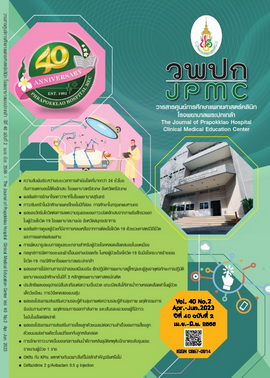Clinical Outcomes of Kawasaki Disease in Surin Hospital
Main Article Content
Abstract
BACKGROUND: Kawasaki Disease (KD) is a systemic idiopathic inflammation of blood vessels commonly found in children aged less than five years which contributes to the leading cause of juvenile heart disease in developed countries. The major complication is Coronary artery aneurysm (CAA) and the standard treatment is the administration of intravenous immunoglobulin within ten days after fever onset to minimize the risk of CAA.
OBJECTIVE: The study aimed to assess the clinical outcomes of Kawasaki Disease treatment among children at Surin Hospital.
METHODS: A retrospective descriptive study was conducted in patients diagnosed with Kawasaki Disease from January 1st 2013 to December 31st 2019. Studied patients were classified as either Complete KD or Incomplete KD following the Kawasaki diagnostic criteria. Data analysis used Package Software. Student t-test for inferential statistics was applied to identify correlations between variables and factors in Complete KD and Incomplete KD groups at a significance level of p≤0.05.
RESULTS: There were a total of 92 eligible Kawasaki patients comprising a male-to-female ratio of 1.87:1. The youngest patient was aged 1 month and 23 days. The highest incidence of disease was among 1-2 year-olds (33.7%). The incidence of Complete KD and Incomplete KD were 70.6% and 29.4%, respectively. The most common symptom and clinical presentation was oral mucosal changes (96.7%). Comparing between Complete KD and Incomplete KD groups, the SGPT level in the Complete KD group was higher than that of the Incomplete KD group at a significance level of p=0.03. There were 87 patients (94.6%) treated with IVIG. The first echocardiography result of 78 patients was undetected for Coronary artery aneurysm. A follow-up study of echocardiography after discharge found that one patient had a Medium coronary artery aneurysm, and the case was referred for advanced management to Maharat Nakhon Ratchasima Hospital.
CONCLUSION: In Surin Province, Kawasaki Disease was mostly found in children aged less than five years, and 87 cases (94.6%) were treated with IVIG. Only one case presented with a Coronary artery aneurysm after follow-up and was referred to Maharat Nakhon Ratchasima Hospital.
Article Details

This work is licensed under a Creative Commons Attribution-NonCommercial-NoDerivatives 4.0 International License.
References
Newburger JW, Takahashi M, Burns JC. Kawasaki disease. J Am Coll Cardiol 2016;67:1738-49.
McCrindle BW, Rowley AH, Newburger JW, Burns JC, Bolger AF, Gewitz M, et al. Diagnosis, treatment, and long-term management of Kawasaki disease: a scientific statement for health professionals from the American Heart Association. Circulation [Intarnet]. 2017[cited 2022 Nov 17];135(17):e927-e99. Available from: https://www.ahajournals.org/doi/epdf/10.1161/CIR.0000000000000484.
Singh S, Jindal AK, Pilania RK. Diagnosis of Kawasaki disease. Int J Rheum Dis 2018;21:36-44.
Crayne CB, Mitchell C, Beukelman T. Comparison of second-line therapy in IVIg-refractory Kawasaki disease: a systematic review. Pediatr Rheumatol Online J [Internet]. 2019[cited 2022 Nov 18];17(1):77. Available from: https://www.ncbi.nlm.nih.gov/pmc/articles/PMC6882052/pdf/12969_2019_Article_380.pdf
Dominguez SR, Birkholz M, Anderson MS, Heizer H, Jone PN, Glode MP, et al. Diagnostic and treatment trends in children with Kawasaki disease in the United States, 2006-2015. Pediatr Infect Dis J 2019;38:1010-4.
Singh S, Vignesh P, Burgner D. The epidemiology of Kawasaki disease: a global update. Arch Dis Child 2015;100:1084-8.
Kim GB, Han JW, Park YW, Song MS,Hong YM, Cha SH, et al. Epidemiologic features of Kawasaki disease in South Korea: data from nationwide survey, 2009-2011. Pediatr Infect Dis J 2014;33:24-7.
Lin MT, Wu MH. The global epidemiology of Kawasaki disease: review and future perspectives. Glob CardiolSciPract [Internet]. 2017 [cited 2022 Nov 18];2017(3):e201720. Available from: https://www.ncbi.nlm.nih.gov/pmc/articles/PMC5856963/pdf/gcsp-2017-3-e201720.pdf
Muangyod N. The incidence and characteristics of Kawasaki disease in Lampang : a case series. Thai J Pediatr 2561;57:257-67.
Verdoni L, Mazza A, Gervasoni A, Martelli L, Ruggeri M, Ciuffreda M, et al. An outbreak of severe Kawasaki-like disease at the Italian epicentre of the SARS-CoV-2 epidemic: an observational cohort study. Lancet [Internet]. 2020[cited 2022 Nov 18];395(10239):1771-8. Available from: https://www.ncbi.nlm.nih.gov/pmc/articles/PMC7220177/pdf/main.pdf
Toubiana J, Poirault C, Corsia A, Bajolle F, Fourgeaud J, Angoulvant F, et al. Kawasaki-like multisystem inflammatory syndrome in children during the covid-19 pandemic in Paris, France: prospective observational study. BMJ [Internet]. 2020 [cited 2022 Nov 18];369:m2094. Available from: https://www.ncbi.nlm.nih.gov/pmc/articles/PMC7500538/
Pilania RK, Bhattarai D, Singh S. Controversies in diagnosis and management of Kawasaki disease. World J ClinPediatr 2018;7:27-35.
JCS Joint Working Group. Guidelines for diagnosis and management of cardiovascular sequelae in Kawasaki disease (JCS 2013). digest version. Circ J 2014;78:2521-62.
Pongwilairat K. Clinical outcomes of Kawasaki disease in children. Buddhachinaraj Medical Journal 2016:33;168-77.
Ha KS, Lee J, Lee KC. Prediction of intravenous immunoglobulin resistance in patients with Kawasaki disease according to the duration of illness prior to treatment. Eur J Pediatr 2020; 179:257-64.

